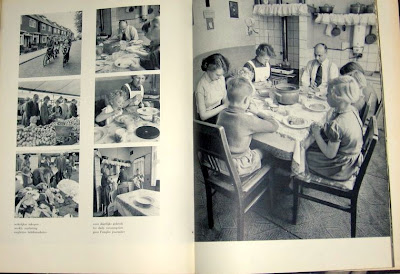Mensen van Menko: 1800 mensen fabriceren stoffen. [Text Martie Verdenius (essay). Photography, layout Nico Jesse].
Enschede / 1956 / 87 p. / hb. / 29x21cm / 144 b&w photographs / bedrijfsreportage en geënsceneerde foto's / productieproces parallel aan een beeldverhaal 'van-de-wieg-tot-het-graf' en variété. / NN / Firmenschrift, Festschrift / Photographie - Monographie - Auftragsphotographie, commissioned photography - Nederland, Niederlande - 20. Jahrh. / Printed by Bosch, Utrecht; Nederlandsche Rotogravure Mij., Leiden (boekdruk en koperdiepdruk). - Opdrachtgever: N.J. Menko NV (100-jarig bestaan). - Beeldverhaal. De lay-out is vergelijkbaar met die van VTF 25 (1957) en Oranje Nassau Mijnen (1953). Werklust, aanpassingsvermogen en concentratie zijn in beeld gebracht in deze drietalige uitgave (Nederlands, Frans, Engels). Bij geënsceneerde foto's van probleemsituaties op de werkvloer zijn gefingeerde dialogen geplaatst. Lit.: Flip Bool, 'Vrijheid in gebondenheid', T. Anema e.a., 50 Jaar fotografie GKf 1945-1995, Amsterdam 1995, p. 9-14Nico Jesse was best known for his photo-book Women of Paris, published in 1954; his candid pictures of women going about their daily occupations convey the vitality of the city. Two years later the book was reprinted in a paperback edition; over the next few years it appeared in several countries, including Japan. Characteristic of Jesse's work, the pictures reflect his unconventional, almost filmic treatment: people are the focal aspect and movement is often an essential element. The use of flashlight to make the figures stand out from the background is another typically Jessean device. It is not so very surprising that he made his name with a book, for his strength lay less in the individual image than in a succession of them.
Nico Jesse had studied medicine and for many years combined his profession as a general practitioner with his passion for photography. His interest in people motivated him in both capacities. In 1956 he retired from general practice to devote himself entirely to photography. His assignments came from various companies; he took photographs for annual reports and/or company publications and for many years photographed Amsterdam's important annual literary event, the Book Ball. He also produced in rapid succession a large number of photo-books featuring European cities and countries. It is clear from these books that he was more interested in the people and atmosphere of a city than in tourist attractions.
To Jesse, photography was always a means of rendering human relationships visible. In 1962 he returned to doctoring, but continued to take photographs. At his death in 1976 he left a large photographic oeuvre which conveys a wonderful picture of the Netherlands and Europe in the fifties and sixties.
Documentaire 28: Bedrijfsboek in beeldRens Holslag en Jaap van Triest
‘Show, don’t tell’ is learned by any commercial writer. The Lecturis Documentary aims to show with examples that this decree is also a recommendation for prefering photographs above texts.
This publication contains a personal collection which visually supports a categorical treatment of business books and which shows the special role of photography in this book genre.
- Author(s):Rens Holslag en Jaap van Triest
- Pages:48
- Size:210 x 297 mm
- Edition:gehecht
- ISBN:9789070108632
- Year:2011
- Design:Jaap van Triest

























Geen opmerkingen:
Een reactie posten